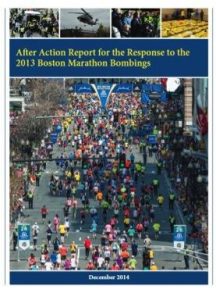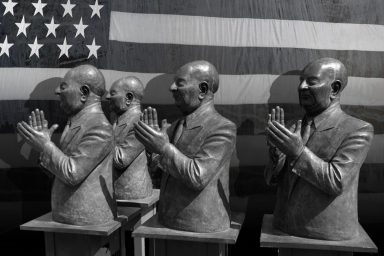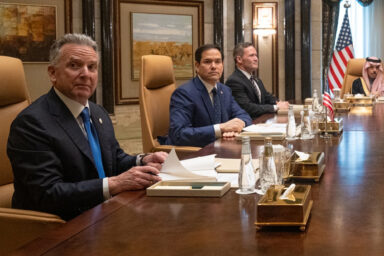The 'After Action Report for the Response to the 2013 Boston Marathon Bombings' was supposed to shine a light on how authorities reacted to one of the worst terrorist attacks on American soil in the past decade. Though it provides some new details, it is notable mostly for its omissions--and how it inadvertently raises still more questions about this baffling saga.
 We asked each member of our Boston Marathon Bombing reporting team to share their personal experience or perspective on one aspect of the bombing or the trial. Stay tuned for more personal perspectives like this as the trial concludes.
We asked each member of our Boston Marathon Bombing reporting team to share their personal experience or perspective on one aspect of the bombing or the trial. Stay tuned for more personal perspectives like this as the trial concludes.
“Read between the lines buffs” will have a field day with a new report out from law enforcement with regard to the Boston Marathon Bombings. Like almost everything else about this case, it suggests to the careful reader that much has been omitted. Not only is the report of interest, but so is its timing. The authorities deliberately delayed releasing it as long as possible—and have done so now that the trial is a done deal.
Partially explained shootouts, illogical timelines and omissions of significance make the “After Action Report for the Response to the 2013 Boston Marathon Bombings” yet another troubling aspect of the trial of convicted bomber Dzhokhar Tsarnaev.
By intent, the report does not include an assessment of the criminal investigation of the bombing, nor does it include intelligence-sharing activities before, during or after the events. The events it does describe are incomplete.
The main thing it does is mix praise with criticism as to how things might be better handled in the future. But it is far less intriguing for the things it says than those it does not say.
***
In addressing how Transit Officer Richard Donohue Jr. was injured during the famed “Watertown shootout” with the Tsarnaev brothers, the report blatantly punts as to culpability, although it is generally agreed Donohue was shot by another officer, not by the suspects.
Though he almost certainly did not actually pull the trigger that injured Donohue, one of the charges upon which Dzhokhar Tsarnaev was convicted Wednesday was injuring the officer. He can legally be charged with such because his alleged actions are what put Donohue on duty at the Watertown scene. And despite labeling the Donohue section of the report “Lack of Weapons Discipline,” the report does not explicitly resolve which officer or agency actually shot and nearly killed Donohue. This means that whoever showed that dangerous “lack of discipline” may not be held accountable or even necessarily given remedial training to avoid such mishaps in the future.
This isn’t the only incident involving questionable actions of Boston law enforcement during the incident that the report fails to address. The report does cite some transgressions on the part of law enforcement, but doesn’t fully explain why or how some of these occurred.
More Shootings
The report does acknowledge what keen observers have long known that there was at least one other shooting incident in Watertown that night. But again, the explanation is inadequate, and limited to one short paragraph:
“Shortly after the firefight, an unmarked MSP black pickup truck was erroneously reported as stolen,” the report says. “This vehicle, with two occupants in it, was then spotted driving on Adams Street, near the scene of the shootout, and fired upon by an officer. Upon further inspection, it was determined that the occupants of the vehicle were a BPD officer and MSP trooper in plain clothes, both of whom were unhurt.”
But that’s all the report makes of this seemingly “mistaken” incident of cop-on-cop gunfire. During Tsarnaev’s trial, his defense attempted to get more information about these other shootings, but was denied access to critical documents by trial court Judge George A. O’Toole. Prosecutors successfully argued that such information was immaterial to the case.
In another instance of “lack of weapons discipline,” the report states that when officers had Tsarnaev surrounded in a Watertown resident’s dry-docked boat, one “officer fired his weapon without appropriate authority in response to perceived movement in the boat, and surrounding officers followed suit in a round of ‘contagious fire,’ assuming they were being fired on by the suspect. Weapons continued to be fired for several seconds until on scene supervisors ordered a ceasefire and regained control of the scene. The unauthorized shots created another dangerous cross fire situation.”
It sounds like a scene from a movie: jittery officers unleash a barrage at a stationary target, and later, chagrined, discover that whoever was inside was not armed. But given that this mob-style thwacking came just hours after a fellow police officer had been killed by unknown assailants, many have wondered if this overkill was truly accidental. Unsurprisingly, the report does not enlighten.
It merely decries purported errors, and suggests that the officers receive more weapons training. It does recommend a broader interagency meeting to discuss how to prevent the kind of officer “self-deployment” that resulted in Donohue’s injury.
More Report Inaccuracies
WhoWhatWhy has previously reported inconsistencies in the narrative provided by Dun “Danny” Meng, the man who said he was carjacked by the brothers. Those inconsistencies, like others, raise serious questions about how ruthless and focused the Tsarnaevs were—and even whether they may have left their purported victim alone in a car, making his escape easy. The After Action Report only deepens the mystery about what actually transpired. The time of the carjacking is listed in the report as11:20 p.m. But that is impossible, because a Bank of America surveillance camera caught Tamerlan withdrawing money from Meng’s checking account at…11:18pm—two minutes before the carjacking had purportedly even begun, a distance away.
Not only is when of the actual carjacking occurred still in question, but where as well. Law enforcement in varying forums cited three separate locations: Richie’s Shell at 1001 Cambridge Street (Boston Police scanner), in the vicinity of Third Street in Cambridge and at 60 Brighton Avenue in Allston. The prosecution eventually settled on the Allston location during the trial, but the report made no attempt to address these discrepancies.
Finally, the report also entirely fails to mention a peculiar incident that unfolded at the John J. Moakley Federal Courthouse on Wednesday, April 17, two days after the bombings. This event still has journalists buzzing, albeit privately.
David Boeri, a reporter for the local public radio station WBUR, was, along with CNN’s John King, among several journalists who reported that day on a supposed arrest in connection to the bombing. Their reports were based on information received from judges and courthouse staff. Boeri reported that he had gone to the federal courthouse after being told an arrest had been made. He’d been told by two senior judges and other officials that they had been ordered to prepare courtrooms for a hearing in connection to the bombing.
Soon after the announcement, however, the assembled media were evacuated due to an alleged bomb threat. “A courtroom was being prepared, and they were even preparing an overflow courtroom at the time,” Boeri said. “That’s when we got a code red alert in the courthouse.”
The following morning the courthouse opened as usual, and it was as if no purported arrests had ever taken place. The After Action Report does not enlighten us on this rather substantial error. And so the 60-page document becomes yet another question mark in a mountain of mysteries.
Additional reporting help from Jill Vaglica.


